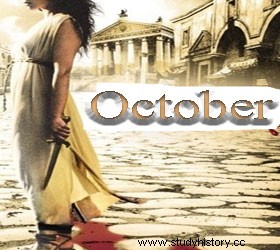As its name indicates, it was the eighth month of the Roman calendar . In the old republican iconography this month was represented as a hunter, with a hare at his feet, birds above him and a pond in the background. In Imperial times it was represented covered with deciduous leaves, since it was in October when the forests and vines changed from summer green to autumnal copper. It was a month dedicated to many agricultural festivals, especially the grape harvest, which took place at the beginning of the month, especially in the southernmost areas of Italy, Africa and Hispania.
On the kalends of October, on the 1st, FIDES, the goddess of good faith, was celebrated; The flamines, priests dedicated to the patriotic cults, went to the temple of the goddess and performed a sacrifice, always with their right hand wrapped in a linen handkerchief.
From the second day of the Kalends until almost the Ides, on the 15th, the Augustalia Games took place, in honor of the first princeps. In addition, every five years the fast of Ceres took place, prescribed by the Sibylline Books, which was traditionally located on October 4.
As we have mentioned, October was a month dedicated to agricultural deities. On the 10th, the Thesmophoria began, the festivities in honor of Ceres, goddess of agriculture.
That same day, the Anodos, the women took the goddess in procession to the waters, seas, lakes or rivers, where they performed fertility rites. It was a female holiday, requiring nine days of sexual abstinence. One of the rites consisted of gathering stubble and rotten remains of the previous harvest that were mixed with the seeds and scattered on the new crops as an act of renewal.
The second day, Nesteia, was dedicated to fasting and retreat commemorating Ceres' mourning after the loss of Proserpina. That night, the women went out at night in procession, carrying candles, dressed in black and with stoles that looked like horsehair. This costume is the clear antecedent of the processional combs and mantillas of our popular festeras.
That same day the men celebrated the Meditrinalia, a festival in honor of Jupiter and Meditrina, goddess of the vines. New wine was mixed with old and toasted with the phrase:«I drink old and new wine; I cure myself of old and new diseases»
The third day of the Thesmophoria, known as Callegénia, was dedicated to all kinds of fertility rites. It was a joyous day with multiple offerings made to Ceres.
On the 13th they celebrated the Fontinalia, the festivities of Fons, god of the fountains
On the 18th, the festivities of Jumentas, goddess of Youth, took place. These festivals were promoted by Nero, who used them to riddle the plebs with his terrible artistic compositions...
On the 19th, the Armilustrio took place, the purification ceremony of the trumpets that marked the end of military operations. The Romans did not fight in winter unless strictly necessary. Maritime trade, Mare Clausum, and military operations were postponed until the arrival of spring.
On the 20th, the festival of the children of each gens (family or caste) was celebrated. There were cakes, games, contests and prizes, and after all this, they got haircuts.
Collaboration of Gabriel Castelló author of Bravery .

